
Here in this post, I will provide online oracle apps dba training. This post has enough material for the beginner to start learning oracle apps dba and start dealing with the small task in it. I have also enough links on my site related to oracle apps dba
What is Oracle EBS
Oracle’s E-Business Suite (also known as Applications/Apps or EB-Suite/EBS) consists of a collection of enterprise resource planning (ERP), customer relationship management (CRM), and supply-chain management (SCM) computer applications Oracle applications is the widely used EBS application in the world. The application is a complex mix of technological components including the Oracle database
Apps DBA Roles & Responsibilities
Oracle Apps DBA is the who manages technology components including the Oracle RDBMS of the EBS application. Oracle’s E-Business Suite requires extensive work from Oracle Application Database Administrator(Oracle apps DBA) to manage the technology stack,Upgrade,patching, Oracle Database Maintenance, Concurrent Manager,performance tuning
Some of the Roles and Responsibilities will be
- Up-gradation ERP instances to the latest Version
- Installation and troubleshooting of Oracle E-business Suit
- Application administration using Oracle utilities like Adadmin and Adrelink.
- Patching using Adpatch and opatch
- Single Node to Multi Node cloning and Multi to Single Node cloning using rapid clone.
- Performance monitoring and tuning of Application Instance, Concurrent Managers and Operating System.
- Design Architecture, installation and Administration of Oracle databases..
- Database performance and tuning.
- Regular monitoring of databases for locks and their resolutions so that the customer does not face any performance issues.
- Database Backup and recovery
So Oracle Application Database Administrator is a rewarding career with great potential to scale new heights.it demands great responsibility and thorough knowledge of the system. Applications DBA should have a clear understanding of the concepts, architecture, and internals to be able to do the job effectively
I am presenting here the Online oracle apps dba Course to equipped the Oracle apps DBA with the various training material, how to tips, and various troubleshooting tips. This basically tells how to become Oracle Apps DBA
Here is the Online oracle apps dba Training Course.
Introduction to Oracle E-Business Suite 11i, R12.1.3/12.2
Oracle Apps is a bundle of E-business applications that provide a complete solution to the business need of the Oracle customers.
Oracle applications utilize a three-tier architecture
The three-tier is Database Tier, Application Tier, and Desktop Tier. The distributed architecture shifts software administration from the desktop onto the middle, or application tier, thus reducing client-side maintenance and lowering administration costs.
What is Desktop Tier
The client interface is provided through HTML for HTML-based applications and via a Java applet in a Web browser for the traditional Forms-based applications. The desktop client with Oracle JInitiator/JRE downloads the applet on demand and the applet is cached locally for future use.
Self Service Application
The HTML-based application is called a self-service application.it does not use Oracle Forms for the interface. They are designed in pure HTML and JavaScript.It dynamically generates HTML pages by executing Java code. It uses a metadata dictionary for flexible layout
The Self-Service Web Applications architecture consists of the following components Web browser, The Oracle HTTP Server, Java Server Pages, JavaBeans, and Servlets
An HTML-based Applications module uses the following access path:
The user clicks the hyperlink of a function from a browser.
The browser makes a URL request to the Web listener.
The Web listener contacts the Servlet engine (OC4J), where it runs a JSP.
The JSP obtains the content from the Oracle E-Business Suite tables and uses information from the metadata dictionary to construct the HTML page.
The resulting HTML page is passed back to the browser, via the Web server.
Forms Based Application
It consists of two-part Forms client Applet and Oracle Jinitiater/JRE
Forms Client Applet
The Forms client applet is a general-purpose presentation applet that supports all Oracle Applications products, including those with customizations and extensions. The Forms client applet is packaged as Java archive (JAR) files. The JAR files contain all Java classes typically required to run Oracle Applications forms.
The Forms client applet displays Oracle Applications screens and supports field-level validation, multiple coordinated windows, and data entry aids like lists of values. The Forms client applet sends user requests to the Forms server and handles responses from the Forms server such as screen updates and pop-up lists.
The required and commonly used JAR files are downloaded from the Web server at the beginning of the client’s first session. Afterward the JAR files remain in the browser’s local disk cache, ready for future sessions until updated versions are released. All updates are installed on the application tier and downloaded to the client automatically through the use of the JInitiator/JRE-enabled Web browser. Other less commonly used JAR files are downloaded on demand, or as needed.
Oracle JInitiator/JRE
The Forms client applet must run within a Java Virtual Machine (JVM) on the desktop. For Oracle Applications the JVM is supplied by Oracle JInitiator/JRE. Oracle JInitiator/JRE works in conjunction with the Web browser.
Oracle JInitiator/JRE is implemented on the desktop client as an ActiveX component (Microsoft Internet Explorer).
When an end-user enters the desired Oracle Applications sign-on URL within the Web browser, Oracle JInitiator/JRE is executed. If Oracle JInitiator has not been installed, the Web browser prompts you to download the necessary installation executable to the desktop client.
Once installed, Oracle JInitiator/JRE runs the Forms client applet and starts an Oracle Applications session.
Application Tier
The Application Tier is the location of servers that provide the business logic and code processing. This tier is sometimes referred to as the middle tier. Each Application release has different technology components in Middle Tier
Here are the main parts of Middle Tier
The Web Server
The Forms Server
The Concurrent Processing Server
The Reports Server( This is present in R11i only)
The Admin Server ( This is present in R11i only)
This tier provides communication between the desktop tier and the database tier. The application tier also supports load balancing among multiple forms servers to provide optimal scalability and processing.
R11i Middle Tier Architecture
R11i Middle Tier consists of Apache, Jserv, Forms 6i, and concurrent Processing server
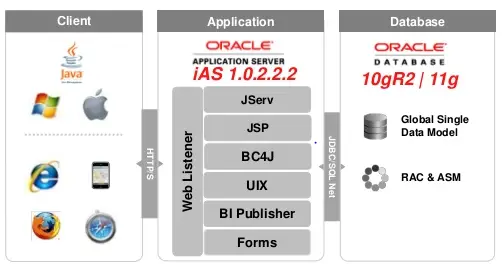
Application Server: iAS1.0.2.2.2
Servlet Container: JServ
Apache: 1.3.19
Forms & Reports: 6i
Java/JDK: 1.4.2 -> 1.5
R12.0/R12.1 Middle Tier Architecture
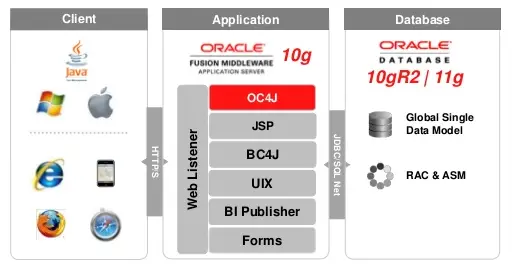
Application Server:10.1.3
Servlet Container: OC4J
Apache: 1.3.34
Forms & Reports: 10g(10.1.2)
Java/JDK: 1.5
We have two 10g Oracle Homes.
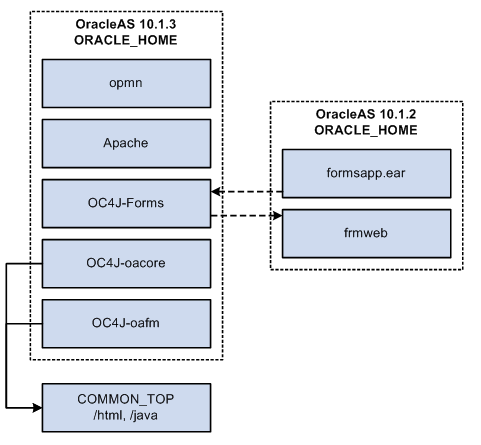
R12.2 Middle Tier Architecture
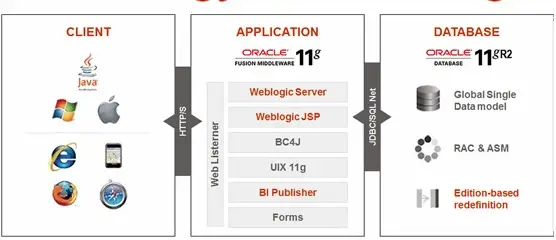
Application Server: 11gR1 Fusion Middleware
Servlet Container: Oracle Web logic Server
Forms & Reports: 10.1.2
Java/JDK: 1.6
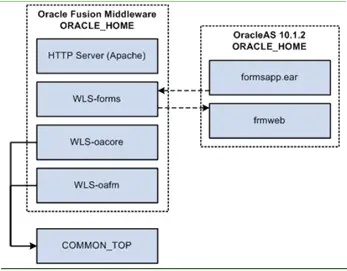
All the Middle Tier technologies working can be understood from the below articles
- Oracle Forms
- Socket mode for forms
- All about Apache in 11i/R12
- Oracle Containers for J2EE
- PLSQL Gateway
- Oracle Concurrent Manager
Database Tier
The database tier contains the Oracle database server that stores and manages all the data maintained by Oracle E-Business Suite. This includes the various types of files in which the tables, indexes, and other database objects for your system physically reside, as well as the database executables.
The database server communicates with the services and servers on the application tier, which mediate the communications between the database and the clients. There is no direct communication between the database and clients.
Products in the Oracle Applications technology layer include:
| Oracle Applications DBA (AD) |
| Oracle Applications Object Library (FND) |
| Oracle Applications Utilities (AU) |
| Oracle Common Modules (AK) |
| Oracle Workflow (WF) |
| Oracle Applications Framework (FWK) |
| Oracle XML Publisher (XDO) |
Oracle Applications DBA (AD)
The Applications DBA product provides a set of tools for the administration of the Oracle Applications file system and database. AD tools are used for installing, upgrading, maintaining, and patching the Oracle Applications system.
Various AD utilities are given below
| AD Administration(adadmin) | It helps in performing general maintenance tasks for Oracle Applications. |
| AD Merge Patch(admrgch) | Merges multiple patches into a single, integrated patch |
| AutoConfig(adconfig.sh) | Manages configuration changes in an Oracle Applications system |
| AutoPatch /adop(AD Onling Patching) |
Applies patches and adds new languages and products to an Oracle. Adop is being used for R12.2 versions Rapid clone[adclone.pl] Used to copy (clone) an Oracle Applications system. Rapid Install Sets up a fully configured Oracle Applications system, including the latest certified technology stack and all patches, mini-packs, and other updates.
Oracle Applications Utilities (AU)
The Applications Utilities (AU) component is used to maintain the Oracle Applications system.
AU hosts a collection of files copied from other products. This allows generating on-site classes of files such as Forms and reports. Generating forms or reports may require access to shared PL/SQL libraries, so these files are copied to AU_TOP as well. We will take a look at the structure of AU in the latter part of the training
Oracle Application Object Library (FND)
The Oracle Application Object Library is a key component of the Applications technology layer. It consists of a collection of reusable code, programs, and database objects that provides common functionality across all products.
Oracle Application Object Library offers many features to make system administration easier, such as security setup and maintenance, and management of concurrent processing and Printer setup.
AOL Feature for End user
| Standard User Interface | Oracle Application Object Library supports the integration of Oracle Applications by providing standardized functionality and capabilities across all products so that the look and feel remains the same from product to product |
| Shared Flexfields value sets | Flexfields allow the entry of certain important information to be standardized across all products. |
| Standard Report Submission (SRS) | The procedure to submit a background report to the concurrent manager using SRS is the same, regardless of the product that owns the report. SRS takes advantage of shared flexfield value sets. |
| Applications Online Help | The presentation of Applications Online Help is also standardized across all products. |
AOL Features for Developers
Every product requires some customization to extend the functionality to make it easier for Business. Oracle Application Object Library also provides capabilities for developers to extend the operation of Oracle Applications by allowing the creation of custom programs that interact with the base modules.
| GUI and coding standards | The same coding and Graphical User Interface (GUI) standards used by Oracle Applications developers are available for custom development. |
| Custom Menu and responsibilities | Custom menus and responsibilities required for the business function can be seamlessly integrated with Oracle Applications. |
| Standard Report Submission | Custom reports developed to extend functionality and required business function can be integrated into Standard Report Submission so that they can be submitted and monitored using the same procedures as other Oracle Applications reports and developers can set up certain menus and responsibilities to access custom reports or standard objects. |
| Flexfields | Flexfields used on custom forms can take advantage of existing flexfield capabilities such as value sets, validation, and security rules. |
| FNDLOAD | AOL provides a generic loader FNDLOAD which can be used to load data from Test to Production |
AOL Features for System Administrators
Oracle Application Object Library provides many features to simplify the administration of Oracle Applications, enabling the system administrator to carry out routine tasks quickly and easily.
| Set up new users | It allows to register new Oracle Applications users, and giving them access to only those Forms, functions, and reports they need to do their job. |
| Manage security | Deciding which users have access to each product, and within a product, which Forms, functions, and reports a user can access |
| Auditing | Monitoring what users do, and when, via comprehensive auditing capabilities |
| System and user profile | Setting user and system profiles to modify the look and behavior of Oracle |
| Manage concurrent Processing | Monitoring and controlling concurrent processing using interfaces such as Oracle Applications Manager (OAM). |
Oracle Application Object Library Security
1) Authentication: Oracle Application Object Library controls access to the data in Oracle Applications via user sign-on and responsibilities. Each user must have a valid user name and password to gain access to Oracle Applications. This is called the Authentication process. We can seamlessly integrate various SSO tools to deliver the authentication process.
2) Authorization: A responsibility is a level of authority in Oracle Applications that lets Applications users access only those functions and data appropriate to their roles in the organization. For example, responsibilities may be used to allow access to a specific product, ledger, operating unit, or to a restricted list of windows, functions, reports, and groups of products, or data groups. This is called authorization
3) When you install Oracle Applications, a standard Applications user called SYSADMIN is created for you. Several default responsibilities are also created. Since the SYSADMIN sign-on is automatically assigned to the System Administrator responsibility, you can use SYSADMIN to create new user sign-ons and assign them to responsibilities. You can also create any custom responsibilities you need.
Various other users are created which help in many other tasks
Oracle Workflow (OWF)
Oracle Workflow delivers a complete workflow management system that supports business process-based integration. It allows for the communication of data between the products
Its technology enables modeling, automation, and continuous improvement of business processes, routing information of any type according to user-defined business rules. Oracle Workflow also provides an infrastructure for the enterprise-wide communication of data related to defined business events
Oracle Workflow lets you model and maintains your business processes using a graphical workflow builder. You can model and automate sophisticated business processes, defining processes that can loop, branch into parallel flows and rendezvous, decompose into sub-flows, branch on task results, time out, and more.
Workflow Components
1) Oracle Workflow Builder provides a graphical drag and drop process designer. You can create and evolve business processes to incorporate existing business practices between your organization and customers or suppliers, without modifying existing business processes and without changing applications code.
2) The Workflow Engine, embedded in the Oracle database, implements process definitions at runtime. The Workflow Engine monitors workflow states and coordinates the routing of activities for a process. Changes in a workflow state, such as the completion of workflow activities, are signaled to the engine via a PL/SQL or Java API.
3) The Oracle Workflow Business Event System provides a workflow-enabled solution for your enterprise application integration requirements. The Business Event System is an application service delivered with Oracle Workflow that uses Oracle Advanced Queuing technology to communicate business events between systems.
The Business Event System uses Oracle Advanced Queuing to propagate messages between communication points on systems, called agents, using a specified protocol.
Oracle Common Modules (AK)
AK is an active data dictionary that enables you to define Oracle Applications
components for the HTML-based Applications, and generate many of the characteristics of Oracle Applications at runtime.
The Oracle Common Modules can be used to develop inquiry applications for HTML-based Applications, without the need for any programming. They allow storage of language-translated labels for all the attributes on a transaction page, thus assisting with the provision of support for multiple languages.
For example, the AK Runtime Dictionary may be used to define an attribute or reusable component such as the customer name attribute, which can be reused any time a customer name field is displayed on an HTML page.
Oracle XML Publisher (XDO)
Oracle XML Publisher is a Java-based product based on the Extensible Stylesheet Language (XSL). Specifically, XML Publisher utilizes the XSL-FO standard to transform XML data into a formatting object (FO). A formatting object contains both data and formatting information and can be further transformed to an output format such as Portable Document Format (PDF).
XML Publisher uses data definitions and templates to produce output reports in the desired format. A data definition is a data source (or a combination of data sources) that either is XML or can produce XML. Examples include output from concurrent programs and Web services. A template is a report definition, which sets out how a report should look. The template layout can be user-specified. Supported templates currently include RTF, PDF Forms, and XSL.
The core components of XML Publisher are a Java-based set of publishing tools accessible via Java APIs from Oracle Applications or from any Java-based application.
FO Processor – The formatting object that results from the application of the XSL-FO template to the XML data is used by the FO Processor to generate the required output document. Currently, the FO Processor only supports PDF as an output format; other formats such as HTML and RTF will be supported in future releases of XML Publisher.
PDF Document Merger – The PDF Document Merger accepts XML data and a PDF document as input, and uses a mapping between the XML and the fields in the document to merge the data into the PDF document.
PDF Form Processor – The PDF Form Processor is used to add attributes such as watermarks to a merged document.
RTF Template Parser – Report templates can be created in the Rich Text Format(RTF) document format, and converted to an XSL-FO format that can be applied to XML data.
I hope you will like the content for this part of oracle apps online training Please do provide feedback
Introduction to Oracle application Filesystem
An Oracle Applications Release 12 system utilizes components from many Oracle products. These product files are stored below a number of key top-level directories on the database and application server machines.
Depending on how you chose to install Applications, these product directories may be located on a single machine (the simplest case) or on multiple machines (the most common type of deployment). Operating system environment settings indicate the location of the various files in the file systems of the database and application tier machines.
As you know already know, the latest offering of apps R12.2 is quite different, I will start with the application filesystem for R12.1 and then I will move on to explain the difference in R12.2
So here is the description of the top Level directory in R12.1
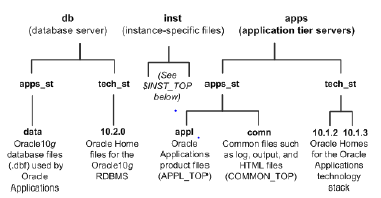
| db/apps_st/data | This directory is located on the database node machine, and contains the system tablespaces, redo log files, data tablespaces, index tablespaces, and database files. This is a standard location but we can change the datafiles to be stored in different directory structures altogether. It can be stored in ASM also |
| db/tech_st/<Oracle Version> example db/tech_st/11.2.0.4 | This directory is located on the database node machine and contains the ORACLE_HOME for the Oracle database. It could be any version like 11.2.0.4. This is a standard location but we can change the Oracle Home to be stored in a different directory structure altogether. |
| apps/apps_st/appl (APPL_TOP) | This directory contains the product directories and files for Oracle Applications. It is present on the Application Node machine. In single-node installation both Database Node and application node are the same |
| apps/apps_st/comn (COMMON_TOP) | Thus directory contains Java classes, HTML pages, and other files and directories used by multiple products |
| apps/tech_st/10.1.2 | This directory contains the ORACLE_HOME used for the Applications technology stack tools components |
| apps/tech_st/10.1.3 | This directory contains the ORACLE_HOME used for the Applications technology stack Java components |
Application Environment and INSTANCE HOME
Oracle Applications makes extensive use of environment settings to locate executable programs and other files essential to Applications operation. These environment settings are defined when you install Oracle Applications. Many of the settings are defined by the information you provide when running Rapid Install, while others have the same values in all installations. The environment settings and their associated values are stored in environment files. Environment files have .env suffix on Unix OS.
Before R12, the environment files were scattered across different product directories/top-level directories. With R12 Oracle introduced the concept of Instance Home.
INSTANCE HOME($INST_TOP)
Oracle Applications Release 12 introduces the concept of a top-level directory for an Applications instance. This directory is referred to as the Instance Home and denoted by the environment variable $INST_TOP
The basic structure of the instance home is: <APPS_BASE>/inst/apps/<context_name>, where APPS_BASE (which does not have or need a corresponding environment variable) is the top level of the Applications installation, and <context_name> is the highest level at which the Applications context exists. For example, the setting of
$INST_TOP might be /u01/applmgr/inst/apps/TEST_TECH, where TEST_TECH, is the context name. All configuration files created by AutoConfig are stored under the Instance Home. This facilitates the use of a shared application tier file system,
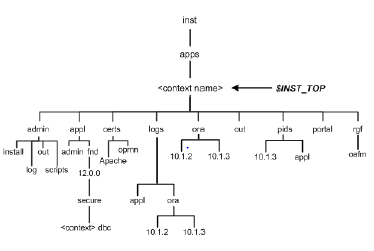
Another advantage is log files can be stored centrally for an instance, and therefore managed more easily.
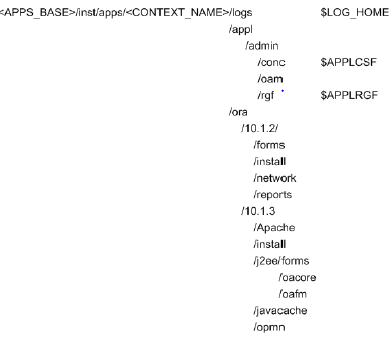
For more information on INST_TOP, read below article
Now lets us take a detailed look at the top-level directories defined above
APPL_TOP directory
This directory contains the product directories and files for Oracle Applications
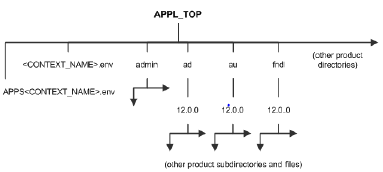
Important Point
The APPL_TOP directory contains:
• The core technology files and directories.
• The product files and directories (for all products).
• The main applications environment file, called <CONTEXT_NAME>.env on UNIX,
• The consolidated environment file, called APPS<CONTEXT_NAME>.env on UNIX,
Rapid Install creates a directory tree for every Oracle Applications product in this APPL_TOP directory, whether licensed or not.
Warning
All Oracle Applications products are installed in the database and the file system, regardless of registration status. Do not attempt to remove files for any unregistered products.
Products Directory
Each product has its own subdirectory under APPL_TOP. The subdirectories are named in accordance with the product’s standard abbreviation, such as INV for OracleInventory Within each product directory is a subdirectory that is named using the base Oracle Applications release number, such as 12.0.0. This directory contains the various subdirectories for the product files.
Within each <PROD>_TOP directory, the product’s files are grouped into subdirectories according to file type and function. The below figure expands the inset to show the full directory structure

Description of product files can be found on the below links
Core Technology Directories in APPL_TOP
The admin, ad, au, and fnd directories are the core technology directories.
| admin | This directory and its subdirectories contain files and scripts used by the AD utilities during upgrade and maintenance processes. These files and scripts include: • The adovars.env environment file, which defines certain file and directory locations • Scripts run during the upgrade • <SID>/log and <SID>/out directories for an upgrade, log, and output files respectively • A <SID>/restart directory where AD programs create restart files |
| ad | This directory and its subdirectories contain installation and maintenance utilities, including • AD Administration (adadmin) • AutoConfig (adconfig.sh) |
| Au | This directory and its subdirectories contain product files that are consolidated in a single location for optimal processing. These files include: • PL/SQL libraries used by Oracle Forms, in the resource subdirectory • Oracle Forms source files, in the forms subdirectory • A copy of all Java files used when regenerating the desktop client JAR files, in the java subdirectory |
| fnd | The fnd (Application Object Library) directory This directory and its subdirectories contain the scripts and programs that are used as the foundation for all Applications products to build data dictionaries, forms, and C object libraries |
COMM Directory(COMMON_TOP)
The apps/apps_st/comn (COMMON_TOP) directory contains files used by many different Oracle Applications products, and which may also be used with third-party products.
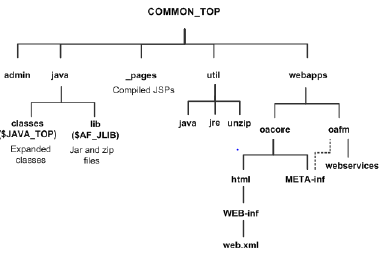
| admin | The admin directory, under the COMMON_TOP directory, is the default location for the concurrent manager log and output directories. When the concurrent managers run Oracle Applications reports, they write the log files and temporary files to the log subdirectory of the admin directory, and the output files to the out subdirectory of the admin directory. The install subdirectory of the admin directory contains scripts and log files used by Rapid Install. The scripts subdirectory of admin contains scripts used to start and stop services such as listeners and concurrent managers. |
| Html | Applications HTML-based sign-on screen and Oracle HTML-based Applications HTML files are installed here. The HTML directory also contains other files used by the HTML-based products, such as JavaServer Page (JSP) files, Java scripts, XML files, and style sheets. Typically, the path will look like: /home/applmgr/apps/apps_st/comn/webapps/oacore/html. Two new subdirectories are META-INF and WEB-INF, introduced to meet J2EE specifications. |
| java | Release 12 introduces some significant changes to the locations in which the various types of Java files are stored. Rapid Install installs all Oracle Applications class files in the COMMON_TOP/classes directory, pointed to by the $JAVA_TOP environment variable. Zip and jar files are installed in the $COMMON_TOP/java/lib directory, pointed to by the $AF_JLIB environment variable (introduced with Release 12). The top-level Java directory, $COMMON_TOP/java, is pointed to by the $JAVA_BASE environment variable. |
| util | The util directory contains the third-party utilities licensed to ship with Oracle Applications. These include, for example, the Java Runtime Environment (JRE), Java Development Kit (JDK), and the Zip utility |
The 10.1.2 and 10.1.3 Oracle Home
These are standard Oracle Home directories. Oracle Applications supports running Multiple Applications components out of Multiple. ORACLE_HOMEs. This multiple ORACLE_HOMEs configuration allows Applications to
utilize new features of the Oracle database and associated technologies in the most flexible manner.
Application Environment Settings
Rapid Install creates several environment files that set up the Oracle database, the
Oracle technology stack, the Oracle HTTP server, and the Oracle Applications
environments.
The location of these in below table
| <CONTEXT_NAME>.env | Stored in Oracle Database Home Path db/tech_st/<Oracle version>( Database Oracle Home) This set the Database related Environment |
| <CONTEXT_NAME>.env | Stored in inst/apps/<context>/ora/10.1.2. ( Oracle 10.1.2 Home) This set the Oracle tools Technology stack setting |
| <CONTEXT_NAME>.env | Stored in inst/apps/<context>/ora/10.1.3.( Oracle 10.1.3 Home) This set the Java Technology stack |
| <CONTEXT_NAME>.env | Stored in apps/apps_st/appl(APPL_TOP). This set the Application Variable like Product top |
| APPS<CONTEXT_NAME>.env | Stored in apps/apps_st/appl(APPL_TOP). This is the consolidated setup file that sets up both the Oracle Applications and Oracle technology stack environments. |
You might ask what is CONTEXT_NAME here
What is context_name
Where the System Identifier (SID) has traditionally been used to identify a file as belonging to a particular Oracle Applications environment, an Applications context is used in an AutoConfig-managed Applications environment such as E-Business Suite Release 12. The default context name as <CONTEXT_NAME>, is <SID>_<hostname>.
Using an Applications context has a number of advantages:
• Simplifies overall management of an Applications system
• Allows easier startup and shutdown of Applications services
Key Environment Variable
| APPLFENV | The name of the environment file, <CONTEXT_NAME>.env. If you rename the environment file, this parameter setting must be updated. |
| PLATFORM | The operating system in use. The value (for example, LINUX) should match the value in the APPL_TOP/admin/adpltfrm.txt file. APPL_TOP The top-level directory for this Oracle Applications installation |
| ADMIN_SCRIPTS_HOME | Directory under $INST_TOP that Identifies the location of scripts such as adautocfg.sh, adpreclone.sh, adstrtal.sh, and adstpall.sh. |
| FNDNAM | The name of the ORACLE schema to which the System Administration responsibility connects. The default is APPS. |
| GWYUID | The public ORACLE username and password that grants access to the Oracle Applications initial sign-on form. The default is APPLSYSPUB/PUB. |
| FND_TOP | The path to the Application Object Library directory. For example, apps/apps_st/appl/fnd/12.0.0 |
| AU_TOP | The path to the Applications Utilities directory. For example, apps/apps_st/appl/au/12.0.0 |
| <PROD>_TOP | The path to a product’s top directory. There is one entry for each Oracle Applications product. |
| PATH | Sets the directory search path, for example for FND_TOP and AD_TOP. |
| APPCPNAM | Indicates whether the format of the concurrent manager log and output files follow 8.3 file name conventions (maximum of 8 characters to the left of the dot and 3 to the right; for example, alogfile.log). If this parameter is set to “REQID” (required), the concurrent manager uses file names that meet 8.3 naming requirements. |
| APPLCSF | Identifies the top-level directory for concurrent manager log and output files if they are consolidated into a single directory across all products. For example, /inst/apps/<context>/logs/appl/conc |
| APPLLOG | The subdirectory for concurrent manager log files. The default is log |
| APPLOUT | The subdirectory for concurrent manager output files. The default is out |
| APPLTMP | Identifies the directory for Oracle Applications temporary files. The default is /tmp on UNIX APPLPTMP Identifies the directory for temporary PL/SQL output files. The possible directory options must be listed in the init.ora parameter utl_file_dir. |
| INST_TOP | Identifies the top-level directory for this instance. For example, inst/apps/<context>. Introduced with Release 12. |
Other Important environment files
| Adovars.env | The adovars.env file, located in $INST_TOP/app/admin, specifies the location of various files such as Java files, HTML files, and JRE (Java Runtime Environment) files. It is called from the main applications environment file,<CONTEXT_NAME>.env. |
| Adconfig.txt | AD utility programs perform a variety of database and file management tasks. These utilities need to know certain configuration information to run successfully. This configuration information is specified when Oracle Applications is installed, and subsequently stored in the adconfig.txt file in the <APPL_TOP>/admin directory. Once it has been created, this file is used by other Oracle Applications utilities. Note: adconfig.txt is created with the APPL_TOP file system, and it shows the tiers that have been configured on a particular node. |
| Fndenv.env | This file sets additional environment variables used by the Application Object Library. |
R12.2 Changes
As already discussed in the previous two parts, R12.2 is a different animal in terms of tech stack and file system
The 10.1.2 Oracle Home remains but 10.1.3 Oracle home has been replaced by Fusion Middleware Home
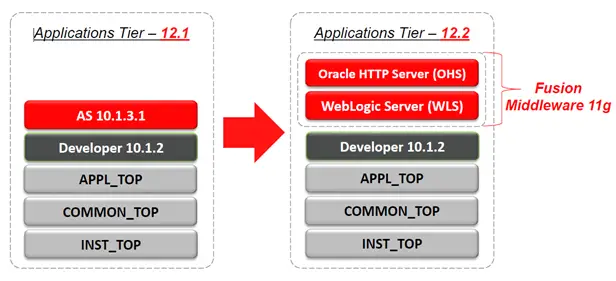
We have Three filesystems to support Online Patching.
| FS1(Production file system) | Used by the current users of the system |
| FS-2 (Copy of Production file system) | Used by the patching tools |
| FS-NE (Non Editioned file system) | It holds AD executables, PATCH_TOP, and CM Log/Output files |
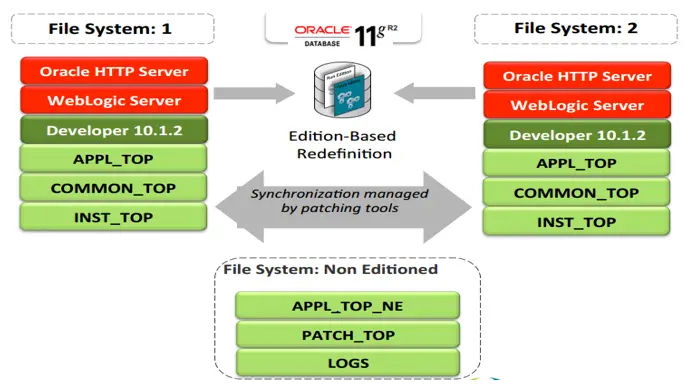
New Environment variable
| Env Variables | Value |
| RUN_BASE | /u99/app/ebiz/EBSR122/VISR122/at1 |
| PATCH_BASE | /u99/app/app/ebiz/EBSR122/VISR122/at2 |
| FMW_HOME | /u99/app/app/ebiz/EBSR122/VISR122/at1/FMW_Home |
| EBS_DOMAIN_HOME | /u99/app/app/ebiz/EBSR122/VISR122/at2/FMW_Home/user_projects /domains /EBS_domain_VISR122 |
| IAS_ORACLE_HOME | /u99/app/app/ebiz/EBSR122/VISR122/at2/FMW_Home/webtier |
- APPL_TOP, COMMON_TOP, INST_TOP, JAVA_TOP &FND_SECURE remains same except COMMON_TOP has more web applications under webapps directory.
- There are various WebLogic servers created in FMW Home: AdminServer, oacore_server1, oafm_server1, forms-c4ws_server1, and forms_server1.
R12.2 Filesystem Layout
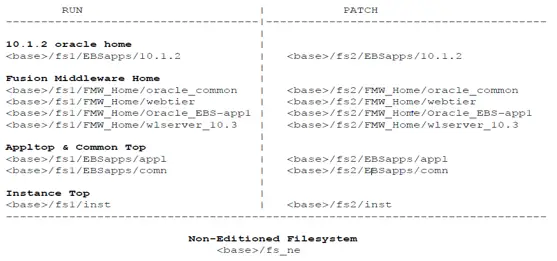
Maintenance Activities
Autopatch and Ad Utilites
Adpatch and Adutilities are used extensively through all the EBS releases. Here are the links which give good information on it and will help understand the process thoroughly
- Adpatch
- Troubleshooting Adpatch failed job
- FND_INSTALL_PROCESSES
- 40 Adpatch question every DBA should know
- AD Utilities(adadmin, adrelink , adident, ADMRGPCH)
- ADCTRL
- R12/11i Product top decoded
- How to restore any Apps executable ( FNDLIBR/ADADMIN/ADCTRL/ADPATCH)
More On Patching
Here we have some advanced concepts for Patching concepts
- Staged APPL_TOP in R12
- Distributed AD
- Improving and Reducing Patch application timing
- How can I determine the effects a patch will have on my system?
- Patch history tables in Oracle Apps
Concurrent Manager
Concurrent Manager is the batch processing system in EBS. It is a very important component. Here are the detailed post written to explain the whole concept
- Oracle concurrent manager
- Concurrent Manager Queries
- Concurrent Manager Interview questions
- Parallel Concurrent Processing
Autoconfig in oracle Apps
EBS manages the configuration of the system through the Auto-config utility. Here is the detailed post on them
- Autoconfig
- How to customize the template for Autoconfig
- FND_OAM_CONTEXT_FILES
- Autoconfig in parallel
- Steps to run Autoconfig in R12
R12.2 Online patching
R12.2 introduced the concept of Online patching. Please go through the below post to understand how it is implemented in R12.2
- R12.2 Online patching cycle summary
- ADOP explained
- Downtime and Hotpatch apply mode in adop R12.2
- How to rollback the patch after failed cutover phase in R12.2
- what happens in cutover phase of adop in R12.2
Cloning
- How to delete the manage server in R12.2
- How to add the manage server in R12.2
- How to clone R12.2 environment
- How to perform Installation of an EBS 12.2 Vision Instance
- R12.2 RapidWiz Installed Components and System Requirements
I hope you like the content on oracle apps dba training. Please do provide feedback. I will be adding more content to it as and when required.
External Resource
Oracle blog

Thanks a lot for this post.
Thanks Sahana
The Concurrent Manger Troubleshooting page is missing. 🙁
Concurrent Manager
Concurrent Manager is the batch processing system in EBS. It is very important components. Here are the detailed post written on to explain the whole concept
Oracle concurrent manager
Oracle concurrent Manager troubleshooting – MISSING PAGE
Top 30 Most Useful Concurrent Manager Queries
Awesome 24 Concurrent Manager Interview questions
Parallel Concurrent Processing
This page is removed. I have added the content in below links only
Oracle concurrent manager
Concurrent Manager Queries
Concurrent Manager Interview questions
Thank you!
Hi thank you so much do u have video link and lab practice manual?
Thanks a lot for sharing information
I am Looking for Oracle Apps DBA course
Oracle apps DBA